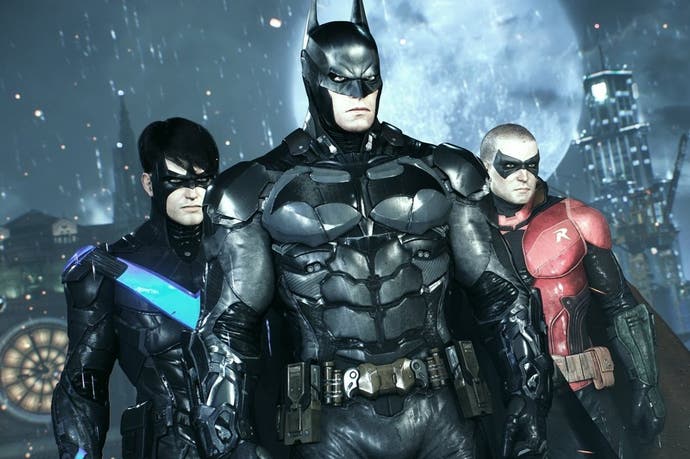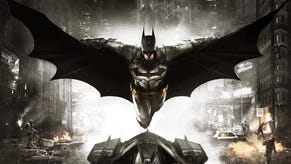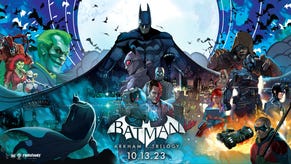Face-Off: Batman: Arkham Knight
Rocksteady delivers on an Unreal promise.
Despite the drama surrounding the PC release leading to its subsequent withdrawal, there's a sense of success in the console space as PlayStation 4 owners, and indeed those on Xbox One, get a superb rendition of Batman: Arkham Knight. It's fair to say Rocksteady sized up each console's strengths well ahead of producing its first current-gen title, and it's paid off in one of the best Batman games we've seen in years. But in playing the game this week, the evidence strongly suggests that Unreal Engine 3's impressive Samaritan tech demo in 2011 paved the way for many of the game's crowning technical achievements.
From the city's crisp neon reflections and bokeh-dotted backdrops to the colour-shaded rain and smoke, the Samaritan teaser didn't just bring a spec feature-list, but a pretty close match for what would become Arkham Knight's final aesthetic. It's an approach that likely struck a chord at Rocksteady at the time, a team that in the same year had just wrapped up development of Arkham City and looked towards its next venture - seemingly too early to catch Unreal Engine 4's wave. Looking at the demo and final game side-by-side, the end result is uncanny in its similarities, especially in the use of lighting effects, point-light reflections, and the integration of Nvidia's Apex tech for cloth simulation across its characters.
Of course, Rocksteady adds much more to the equation on its own. The scale of Gotham City is unlike anything we've seen on the engine, as well as the procedural method to enemy encounters - cut-scenes that dynamically weave into play as you traverse the city (often inviting you to a new side-quest). The seamless nature of the animation system, with its single camera swoops to and from the Batmobile cockpit, also deserves huge credit. An absence of loading screens also sets it apart from last-gen hardware, where RAM proved a limitation in streaming open-world environments - particularly as dense as this rendition of Gotham.
But how has Arkham Knight proven such a solid fit for current-gen hardware? Bearing in mind the specs for PS4 and Xbox One were largely a mystery to developers at the start of development in 2011, some guesswork was needed. In Rocksteady's case, the indications are that the team hedged its bets correctly from the start, and the pay-off has been huge this year.
In an interview with marketing director Dax Ginn, he explains: "our tech guys - and especially our lead engine coder Dustin [Holm], he was building an engine that was a prediction of the horsepower that he thought the consoles [would have]. And then when we finally got our hands on the hardware, he was like 'Yeah, no worries, I always knew it was going to be this way'."
The visual return is easy to see; on PS4 the game runs at a full native 1920x1080 resolution many hoped would be the standard this generation. It's perhaps not the crispest example of a full-HD game, owing to its heavy post-process anti-aliasing, and a film grain filter - but the visibility of Gotham's city-line is all the clearer for running at this pixel count. Pop-in is something that flares up from time-to-time, but overall the game looks gorgeous in motion and rarely shows its rough edges.
On Xbox One, every single effect and detail carries directly across from the Sony release. Texture mapping is identical, and in terms of asset streaming there are only minor variances between the two versions when it comes to texture pop-in. However, it's a familiar scenario in the resolution stakes, and we get an upscaled 1600x900 on Xbox One that causes more pixel-crawl on distant buildings than we see on PS4. This is accentuated by Arkham Knight's post effects - the same gamut of filters as seen on PS4 - where a chromatic aberration pass heightens the effect of pixel-crawl in brightly-lit areas.
From top to bottom, these two versions are otherwise identical. The resolution difference is the only aspect that divides the two visually, and both deliver results eerily close to Epic's 2011 demo. The only apparent downgrade from that original vision is in reflection detail; Arkham Knight's neon signs rarely appear as sharp as that demo's, and nor are their positions always relative to the scenery. Even so, it's an effort that comes close to an ideal that few suspected would materialise as a full game, let alone one with a Batman theme.
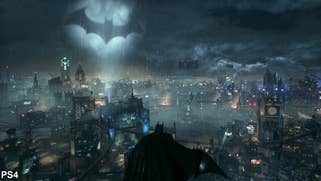


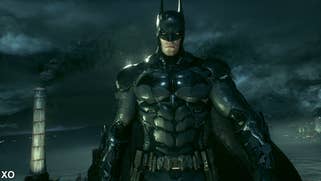

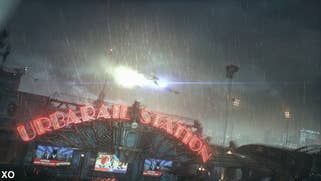


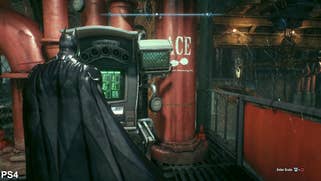


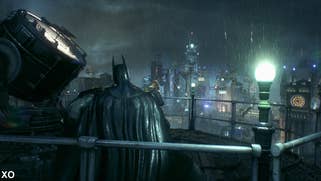

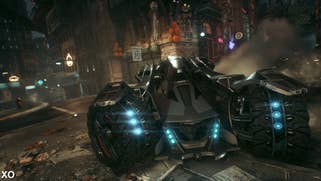
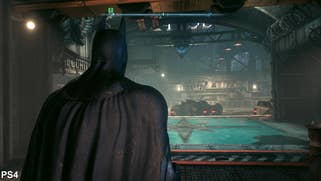
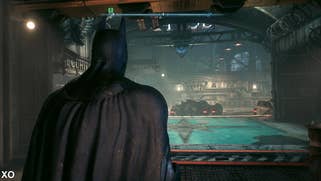
As a target real-time demo running on a top-of-the-line Nvidia setup (three GTX 580s in SLI at the time), the Samaritan sampler inevitably had a leg-up in performance so early on. With today's consoles, the target is rightly evaluated at 30fps for both PS4 and Xbox One, with adaptive v-sync engaged on each should a frame run over-budget. It's a setup that falls in line with most open-world games this generation, and with a velocity-based motion blur in place the results are very respectable.
Xbox One's performance profile is very similar to its visual divide when compared to PS4; it's close, but falls shy in certain regards. The worst dips we see from either are at the 26fps mark when first driving the Batmobile. Tearing is invoked here, but this settles down within a second on both platforms, and play unfolds without any major issues from there. For the majority of the time, PS4 and Xbox One are neck-and-neck at 30fps, but both are prone to minor hiccups with fast movements across the city.
On balance, Xbox One shows a trend of more hiccups and tears overall as we glide through the city, though the difference isn't stark. It's not enough to detract from the playing experience on either platform, but it's fair to say PS4 is a smoother performer as an overarching rule. Impressively, as of patch 1.02 playback on Sony's platform is even more polished than results we experienced in our review code - and the fully patched Xbox One release surpasses this older Sony build too. It's a very solid 30fps turnout for both, and in light of the frame-pacing issues experienced in recent games, a real breath of fresh air.
Batman: Arkham Knight - the Digital Foundry verdict
The PC's dire situation may cast a shadow over its launch, but the fact remains that Arkham Knight is an exceptional release on console. It also says a lot about Rocksteady's assessments of PS4 and Xbox One when designing the game, having laid out the game's blueprint well before truly knowing either console's specs. In the end, it's a superb release whether you go with Microsoft or Sony's hardware - though the preference is with the clarity of PS4's 1080p output. Also weighing in the slightly smoother performance overall when gliding through Gotham's streets, it's fair to say this is the technical champ of the two.
Added to that, PS4 also brings exclusive extras such as The Scarecrow Nightmare pack - a selection of three racing-based missions, plus more character skins (including a take on the classic 60s Batman). For completists of the series these are hard to overlook, though they're not pivotal to the main story in any sense. Xbox One owners may be rewarded for their patience though; based on the game's Amazon listing all these extras are due on other platforms before the year's out.
Even with its basis in Unreal Engine 3, Arkham Knight counts among the most cutting-edge games released for this generation - making the most of PS4 and Xbox One with a truly open-world Gotham, superb lighting and effects, and seamlessly smooth animations. As games using the fourth iteration of the engine just start to trickle through, there's a real sense that this is also the last major title to use Epic's older engine. It's a great send-off for a technology that clearly had greater potential than the last generation of consoles could deliver, and with the Arkham saga seemingly sown up, we can't wait to see what Rocksteady's chooses to take on next.
